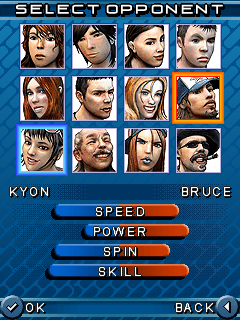
Before Rockstar raised the gaming world's eyebrows with the peerless Table Tennis on home consoles, ping pong was nothing more than a dated pursuit confined to dilapidated tables in north-western youth centres on rainy Sunday afternoons.
However, it was an astute move by Rockstar. Unlike tennis, which consists of big sweeping movements, table tennis demands delicacy of touch and pinpoint control, and the developer was predictably equal to the task of reproducing these finer qualities.
It's fair to assume that Shadow Light Games is paying a small amount of homage. Table Tennis Star is shot-through with flashes of familiarity, from the characteristic cell-shaded avatars to the telling inclusion of the word 'star' in the title. And, of course, the fact that this game, like Rockstar's, is fantastic.
Let's start with the graphics, since they're the first thing to hit you. In a word, they're incredible. The tables and backgrounds have been pre-rendered in 3D and then frozen, allowing immense detail at the cost of camera movement and, in the truest sense, a 3D environment.
However, the impeccable physics model, the perspective illusion of depth, and the parallax scrolling work together to create an impression of 3D so convincing that you'll never know the difference, and the level of high-resolution detail in the apparently 3D environments is stunning. Table Tennis Star is comfortably amongst the best-looking mobile games we've seen.
There are three environments – an indoor arena, a Californian beach hut, and a Chinese courtyard – and each of them looks breathtaking. The courtyard in particular is a masterclass in intelligent design, with photorealistic flagstones, a raised walkway marking out the points of parallax depth, and patches of light dappling the table from between the trees overhead.
And all of this is integrated into the game, rather than pinned to the back of it like a stage canvas. If your opponent fails to reach a shot, the ball bounces into the scenery, colliding with whatever object it meets, be it a rock, a hut, or a surfboard.
Of course, this phenomenon says as much about the physics as the graphics. Before we move onto the science part, though, we're going to take a look at the remarkably economical controls.
There are three stages to every shot. First, you need to get the paddle into place by moving it left and right with '4' or '6', and forwards and backwards with '2' or '8'.
Once the paddle is in place, it automatically fixes to the spot and '4' and '6' then enable you to choose the direction in which you want to hit the ball, while '2' and '8' make it possible to impart topspin or backspin. Smash, meanwhile, is assiged to '5'.
Finally, once you've hit the ball you can apply aftertouch, using '4' and '6' again to swerve it left or right.
If this all seems fiddly in writing, in practice the controls are immediately intuitive. The compulsion to play comes partly from the organic, tactile pleasure it gives.
There are power meters beneath and to the side of the table showing how acute an angle you're hitting the ball at, how much backspin you're applying, how much aftertouch, and so on. There literally isn't a place on the table that you can't reach with practice and finesse.
Everybody knows that video games are art, but the best competitive games convince you that playing them is an art, too, and Table Tennis Star is one of these. Using directional control you can put the ball near the edge of the table, but only with aftertouch can you place it at the edge, and only with the subtlest touch can you keep it from swinging out too far. The satisfaction of getting it right is immense.
Because the physics are modelled so thoroughly, it's actually possible to hit a ball off the rim of the table, making it unreachable. Sometimes, the same thing happens to you: a shot comes across the table that you just can't hit because by sheer fluke it's shot off haphazardly.
But the point is, this never feels unfair, because this is exactly what happens in real life. Table Tennis Star may give you the supernatural power of aftertouch, but there's nothing supernatural about the world in which you use it, and the freewheeling flair of the action is underpinned by irreproachable foundations.
Since we're here to criticise, we'll point out that the relative paucity of game modes and the lack of wireless multiplayer is a niggle. The virtual competition is charismatic and wily enough that confinement to single-player is no hardship, but the sheer excellence of the gameplay makes the omission of multiplayer too irksome to ignore.
Still, when the most damning criticism you can make about a game is that you wish you could share it with your friends, you know you're onto something good.
Table Tennis Star

